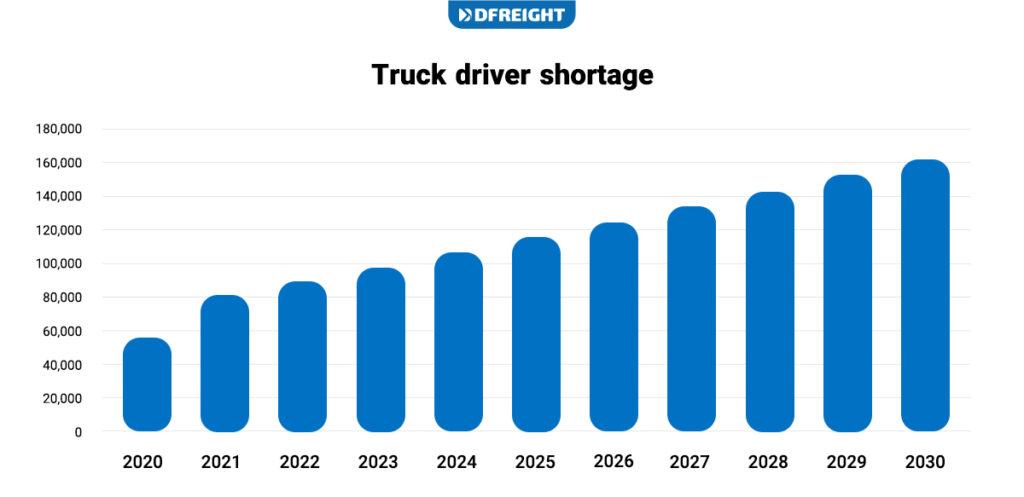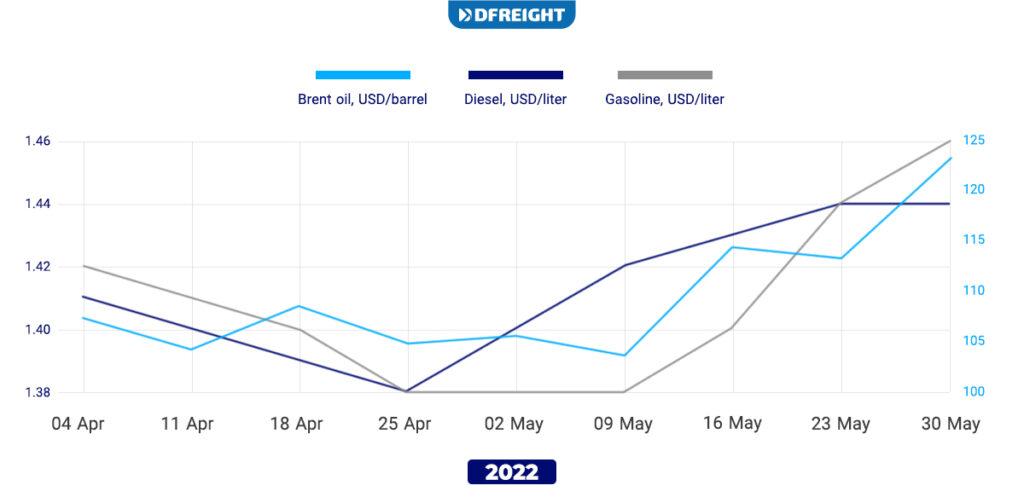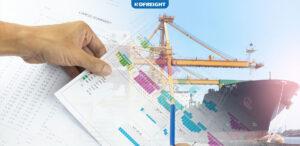The freight market is a booming and popular industry with many potentials and a promising future. This industry will continue to be used as the world becomes more digital. The freight market in the UAE is currently experiencing a healthy growth trend. This is mainly due to the increasing demand for transportation services and goods and the economy’s growth. Freight market updates can help you understand the current market conditions, trends, and pricing and give insight into the freight market’s future.
If you’re looking to join the freight market of the future, sign up with DFreight now! Our digital freight forwarding services will help your business save time and money and give you peace of mind knowing your goods are safe. Join today to access our streamlined freight services and unlock the potential of the freight market future, or simply get a free quote from the below section.
Table of Contents
Worldwide Freight Market Update
Some challenges in the worldwide market are currently significant and influential, the most important of which are listed below:
2022 Russian-Ukraine Crisis
The airspace over Russia and Ukraine is not currently closed, but flights in the area are being redirected; as a result, it causes congestion on other air routes. The effect of the 2022 Russian-Ukraine Crisis on the Logistics industry is expected to be both significant and far-reaching. For many businesses, the ability to move goods and materials quickly and efficiently is critical to their success. The Crisis is likely to cause disruptions in the supply of goods and materials and in the transportation of goods and materials. This could lead to significant delays and disruptions in the logistics industry and could have a negative impact on the economy as a whole.
Shortage of Drivers
There is no doubt that the logistics industry is facing a driver shortage. This is having a profound impact on businesses that rely on logistics to move their products and services. The driver shortage is caused by several factors, including an aging workforce, a lack of interest in driving as a career, and strict driver qualifications. The aging workforce is perhaps the most significant factor in the driver shortage.
As baby boomers retire, fewer younger workers will replace them. This is compounded by the fact that driving is not seen as an attractive career option for many young people. The pay is often low, and the hours can be long and unpredictable. Stricter driver qualifications are also causing the driver shortage. To obtain a commercial driver’s license, applicants must now pass a more demanding test and have a clean driving record. This has resulted in a smaller pool of qualified drivers.
The driver shortage is having a ripple effect throughout the logistics industry. Businesses are struggling to find drivers to move their products and services. This is leading to delays and cancellations and an increase in prices. The driver shortage is a significant challenge that the logistics industry must address to remain competitive.
At current trends, the shortage could surpass 160,000 in 2030. This forecast is based on driver demographic trends, including gender and age, as well as expected freight growth
American Trucking Associations
If no solution is found, the process of this crisis until 2030 can be seen in the graph below:

Fuel Prices
The effect of fuel prices on the freight market is both direct and indirect. The immediate result is the most obvious, as fuel prices directly impact the truck’s cost. The indirect effect is less blatant but just as important. Fuel prices impact the cost of shipping goods, affecting the demand for freight services. When fuel prices are high, the cost of shipping goods increases, leading to a decrease in demand for freight services. The figure below shows the variations in global fuel costs over two months (globalpetrolprices).

Ports Congestion
Port congestion has severely impacted the freight market during the last few months. Due to the congestion, items have been delayed in transportation, resulting in a decline in demand for freight services. As a result of the drop in orders, freight prices have dropped, as carriers are eager to lower their rates to attract business. In the following months, port congestion will likely relieve, resulting in increased demand for freight services and increased prices.
Technologization
The freight industry also faces challenges from new technologies developed to ship goods more efficiently. These new technologies allow small freight companies to compete with large global freight companies. The growth of e-commerce is another kind of technologization that, of course, is growing in popularity, causing a decline in the demand for traditional freight services. This is because people can order goods online and deliver them in a door-to-door mood without using a freight company.
These modern transportation methods, such as using IoT and analyzing big data, are making it possible for goods to be transported more quickly and efficiently. This is causing a decline in the demand for traditional freight services.
Scams
The freight industry has recently seen a rise in scams as criminals have become more sophisticated in their methods. This has created a challenge for companies committed to providing a safe and reliable service. There are several steps to protect customers from scams, such as vetting drivers and partners and having a dedicated team that monitors suspicious activity. They also should work closely with law enforcement to report any attempts to defraud customers.
DFreight is a company that can provide a service that customers can trust. Anyone looking for a freight company should consider using our services, as we are confident that we can provide a safe and reputable service.
Environment Issue
The world faces several environmental issues, and the logistics industry is no exception. Here are some of the most critical environmental problems that the logistics industry is facing today:
- Climate Change: It is one of our most pressing environmental issues. The logistics industry is responsible for significant greenhouse gas emissions, which are vital in mitigating climate change.
- Sustainability: Sustainability is another key environmental issue for the logistics industry. The logistics sector has a massive impact on the environment, so it is vital to ensure that its practices are sustainable.
- Waste: Logistics companies generate a lot of waste, so it is crucial to ensure that it is appropriately disposed of and managed.
- Pollution: Pollution is another significant environmental issue for the logistics industry. The logistics sector generates a lot of pollution, so it is vital to reduce it.
- Energy: The logistics sector is a significant energy consumer, so it is crucial to ensure that its practices are energy-efficient.
The logistics industry has a significant impact on the environment. Therefore, addressing the most pressing environmental issues the sector faces is essential. The industry can help mitigate climate change’s effects, ensure sustainability, and reduce pollution and waste by doing so.
Stay Innovative
The worldwide freight industry is constantly changing, making it difficult for companies to keep up with the latest regulations. This can be a significant obstacle for companies that must continuously innovate to stay compliant. Not only do they need to be aware of changes in rules, but they also need to be able to adapt their processes and procedures quickly. This can be a challenge, as it requires high flexibility and agility. This can be a delicate balance to strike and one that can be difficult to maintain.

Freight Market Update in the UAE’s Surrounding Nations
The freight market in the MENASA countries has recently seen some updates. One of the most notable changes has been the increasing number of logistics companies operating in the region. This has led to increased competition and, as a result, lower prices for shippers. In addition, developing new infrastructures, such as the new Jebel Ali Port in Dubai, has made the region more attractive to foreign logistics companies.
As a result of these changes, the freight market in the Middle East is expected to continue to grow in the coming years. The growth of the freight and logistics market in the Middle East and Africa is expected to positively impact the freight market, as it will increase demand for freight services.
Freight Market Update in the UAE
UAE’s strategic location at the crossroads of east-west shipping routes makes it an essential link in global trade. The UAE’s ports and logistics infrastructure are among the best in the world, and the country is investing heavily to improve its capabilities further. The UAE’s freight market is constantly evolving, and the government is taking steps to ensure that it remains an attractive destination for businesses. The UAE has several advantages that make it an attractive freight market, including its strategic location, excellent infrastructure, and commitment to trade liberalization.
There has been a lot of activity in the freight market in the UAE recently. Companies are scrambling to get their hands on the latest information and update their prices accordingly. This is good news for consumers, as they can get the best deals on their shipments. However, it can also be a bit of a hassle for companies that are not used to the ever-changing landscape of the freight market. That is why staying up-to-date with the latest news and trends is essential.
Since the early 2000s, the United Arab Emirates (UAE) has experienced rapid growth in its freight market. This is primarily due to the country’s strategic location at the crossroads of East and West, as well as its vital infrastructure and logistics capabilities. In recent years, the UAE has been working to further improve its freight market by investing in new port and airport facilities and expanding its rail and road networks. By 2025, the market is expected to produce more than USD 30 billion (Ken Research).
Warehouses
Many new warehouses are being built in the UAE as the country continues to grow and develop. These warehouses are typically used for storing and distributing goods and can be found in industrial areas or near ports and airports. Some of the most popular new warehouses in the UAE include the Dubai Logistics City, the Jebel Ali Free Zone, and the Abu Dhabi Industrial City.
Competitive Market
The UAE’s freight market is highly competitive, with many local and international freight companies operating. The competition is particularly intense in the sea freight market, where the UAE’s ports are located. To win market share, freight companies offer services and prices designed to attract customers.
UAE Ports
The past few years have seen tremendous progress in the UAE ports. This is due to the intense focus on infrastructure development and the expansion of the seaport network. The number of deepwater ports in the UAE has increased significantly, and facilities and services have improved. The UAE ports can now handle larger ships and more cargo, and they are better equipped to meet the needs of the shipping industry.
The UAE’s maritime sector continues its strong growth in line with its economic visions and plans to attract international investment and business opportunities. In 2021, several key projects were in the pipeline, including the expansion of Khalifa Port, the development of the Fujairah Port, and the construction of the new Kizad Port.
The UAE Ports report 2019 showed that the country’s ports handled about AED 943 billion of trade in 2018, with a total volume of 137 million containers and 97 million passengers. In 2019, the country’s ports handled about AED 1.05 trillion of trade, with a total volume of 152 million containers and 106 million passengers.
Khalifa Port, the first semi-automated container port in the Middle East, is being expanded to accommodate the world’s largest container vessels. The AED 6 billion expansion project will increase the port’s capacity to 22 million TEUs by 2022. The expansion will include the construction of a second container terminal with a total area of 2.65 million square meters and developing a new 2.2-kilometer quay wall. The expansion will also include the construction of a new 1.6-kilometer deepwater channel and a new 2.7-kilometer approach channel.
Fujairah Port, the only multi-purpose port on the UAE’s east coast, is undergoing a significant expansion that will increase its capacity to accommodate the world’s most giant crude oil tankers. The AED 3.5 billion expansion project will increase the port’s capacity to 20 million TEUs by 2022.
The expansion will include the construction of a new 1.8-kilometer deepwater channel, a new 2.4-kilometer quay wall, and the development a new container terminal with a capacity of 2.65 million TEUs. The expansion will also include the construction of a new 2.7-kilometer approach channel and the development of a new oil terminal with a capacity of 10 million barrels.
Kizad Port The AED 7 billion Kizad Port is being built in the emirate of Abu Dhabi. The port will have a capacity of 20 million TEUs and is expected to be operational by 2022. The port will include the construction of a new 2.4-kilometer deepwater channel, a new 2.7-kilometer quay wall, and the development of a new container terminal with a capacity of 2.65 million TEUs. The port will also include the construction of a new 2.7-kilometer approach channel and the development of a new oil terminal with a capacity of 10 million barrels.
Abu Dhabi International Airport is also expanding, with a new terminal and runway open in 2019. The airport is investing $1.6 billion in expansion projects between 2016 and 2021.
Qatar’s Hamad International Airport is also expanding, with a new terminal opening in 2019. The airport is investing $17.6 billion in expansion projects between 2016 and 2027.
With all of these explanations, it is apparent that the UAE has the potential and willingness to expand its transportation business.
Conclusion
The freight market is currently in flux as the economy transitions from a growth phase to a more sustainable one. The market is expected to continue to grow at a slower pace soon as more shippers transition to freight transport that is more environmentally friendly. Airlines are also increasing their fares, seeking to make up for revenue lost due to the weak economy. Overall, the freight market is expected to remain stable shortly.
Still have a question? Check DFreight and contact us so we can provide you with specific information not already included in this article.
What are the leading countries from which the UAE imports?
The UAE imported goods from the top five countries: the United States, China, Germany, France, and the United Kingdom.
Is the freight market expected to grow?
Based on existing conditions and statistical forecasts, the transportation business is predicted to increase significantly in the following years.
What are the top freight markets in UAE?
The top freight markets in UAE are Dubai and Abu Dhabi.
Who issues freight market updates?
Government agencies, research firms, or industry associations typically issue freight market updates.
What factors are considered in freight market updates?
Factors considered in freight market updates include economic indicators, transportation data, and infrastructure developments.














